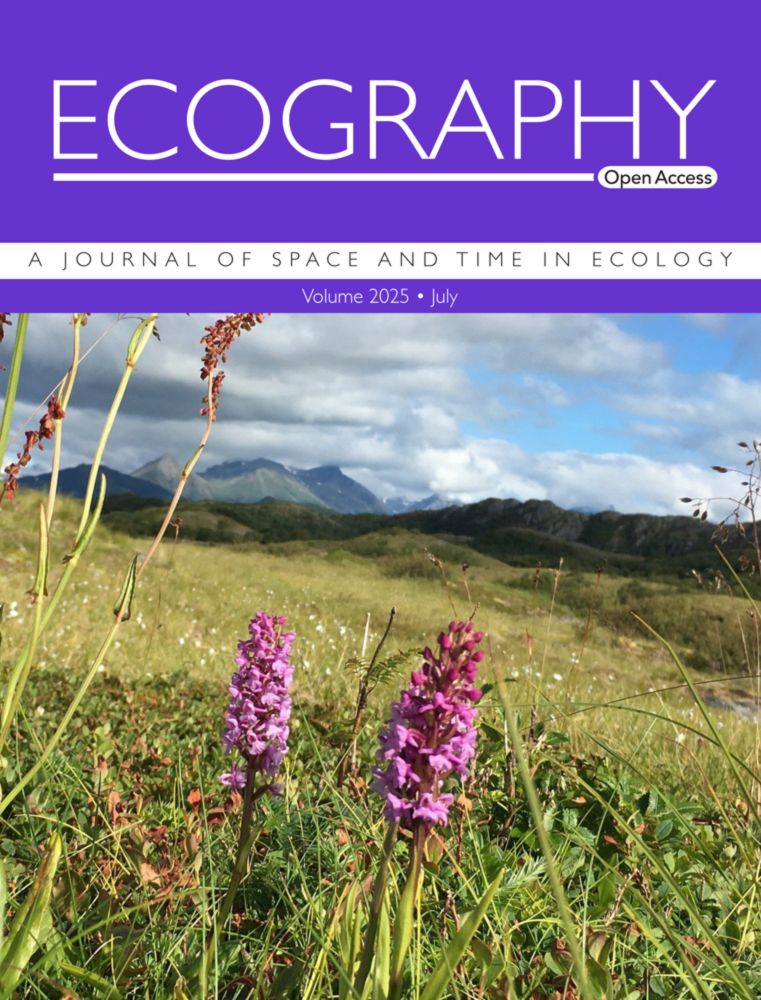MAPASLab at uvigo. Member of _PMMV_ and MujerPiesTierra. Feminist. She/her/ella.
🔗 doi.org/10.1002/ecog...
By Sara Gamboa, Sofía Galván, @marsobral.bsky.social
@hdezfdez.bsky.social & @saravarela.bsky.social
📊 Over 3600 mammal species
🌍 10 global biomes
🍽️ A global buffet.
#Macroecology #FunctionalEcology #Mammals #TrophicEcology

🔗 doi.org/10.1002/ecog...
By Sara Gamboa, Sofía Galván, @marsobral.bsky.social
@hdezfdez.bsky.social & @saravarela.bsky.social
📊 Over 3600 mammal species
🌍 10 global biomes
🍽️ A global buffet.
#Macroecology #FunctionalEcology #Mammals #TrophicEcology
📌Who’s irreplaceable?
⛓️Who’s holding the structure together?
🧩And what happens when environments shift faster than species can move?
This is what functional ecology must answer.
📌Who’s irreplaceable?
⛓️Who’s holding the structure together?
🧩And what happens when environments shift faster than species can move?
This is what functional ecology must answer.
Species don’t just divide the world by where they live.
They divide it by what they eat, and how they access that food over time and space.
Ecological roles aren’t just about traits.
They’re about context.
Species don’t just divide the world by where they live.
They divide it by what they eat, and how they access that food over time and space.
Ecological roles aren’t just about traits.
They’re about context.
It's not broad omnivory. It’s mobile predation.
A different kind of generalism. 🕷️🐭
It's not broad omnivory. It’s mobile predation.
A different kind of generalism. 🕷️🐭
Meanwhile, moderate generalists are the real keystones.
They fill the space, link ecosystems, and stabilize food webs.
They’re not flashy, but they hold the fort.

Meanwhile, moderate generalists are the real keystones.
They fill the space, link ecosystems, and stabilize food webs.
They’re not flashy, but they hold the fort.
If many species do similar things, ecosystems are buffered. If one is lost, another can take its place.
That redundancy is a kind of ecological insurance.
🛟🛠️
If many species do similar things, ecosystems are buffered. If one is lost, another can take its place.
That redundancy is a kind of ecological insurance.
🛟🛠️
But in harsher biomes, the story changes.
Specialists shrink. Generalists step in.
And trophic diversity becomes fragile.
But in harsher biomes, the story changes.
Specialists shrink. Generalists step in.
And trophic diversity becomes fragile.
They often occupy dietary roles already covered by generalists.
Yes, a few have truly unique diets—ecological “weirdos” with no substitutes.
But most specialists are nested within generalist space.
Their diets are rarer, but not necessarily novel.

They often occupy dietary roles already covered by generalists.
Yes, a few have truly unique diets—ecological “weirdos” with no substitutes.
But most specialists are nested within generalist space.
Their diets are rarer, but not necessarily novel.
Especially moderate generalists.
They take up most of the trophic space in every biome, even in extreme environments like tundra or taiga. ❄️
They're the flexible backbone of global mammal communities.

Especially moderate generalists.
They take up most of the trophic space in every biome, even in extreme environments like tundra or taiga. ❄️
They're the flexible backbone of global mammal communities.
Then we projected it across ten global biomes:
from lush tropical forests to frozen tundra.
How full is the dietary space in each biome?
And who’s filling it?

Then we projected it across ten global biomes:
from lush tropical forests to frozen tundra.
How full is the dietary space in each biome?
And who’s filling it?
Rain or drought. Summer or winter☀️🌩️❄️.
If resources run out, there’s nowhere else to go.
Generalists, by contrast, can follow the seasons or shift habitats.
More options, more resilience. 🌍
Rain or drought. Summer or winter☀️🌩️❄️.
If resources run out, there’s nowhere else to go.
Generalists, by contrast, can follow the seasons or shift habitats.
More options, more resilience. 🌍
🔴 Specialists – live in only one biome
🟡 Moderate generalists – live in 2–4 biomes
🔵 Extreme generalists – 5 or more
This isn’t about dietary generalism.
A species can have a narrow diet and still thrive in many environments
🔴 Specialists – live in only one biome
🟡 Moderate generalists – live in 2–4 biomes
🔵 Extreme generalists – 5 or more
This isn’t about dietary generalism.
A species can have a narrow diet and still thrive in many environments

And we didn’t classify them by what they eat.
We first asked: how many biomes does each species live in?
And we didn’t classify them by what they eat.
We first asked: how many biomes does each species live in?
Who eats what — and where — across the world’s biomes?
How does being a specialist or a generalist affect that?
And what that means for biodiversity?
🔍🦓🌍
nsojournals.onlinelibrary.wiley.com/doi/10.1002/...

Who eats what — and where — across the world’s biomes?
How does being a specialist or a generalist affect that?
And what that means for biodiversity?
🔍🦓🌍
nsojournals.onlinelibrary.wiley.com/doi/10.1002/...
🌿 species richness
🐋 body size
🌡️ climate tolerance
But one question has remained surprisingly underexplored:
How do mammals divide up the global buffet?

🌿 species richness
🐋 body size
🌡️ climate tolerance
But one question has remained surprisingly underexplored:
How do mammals divide up the global buffet?

